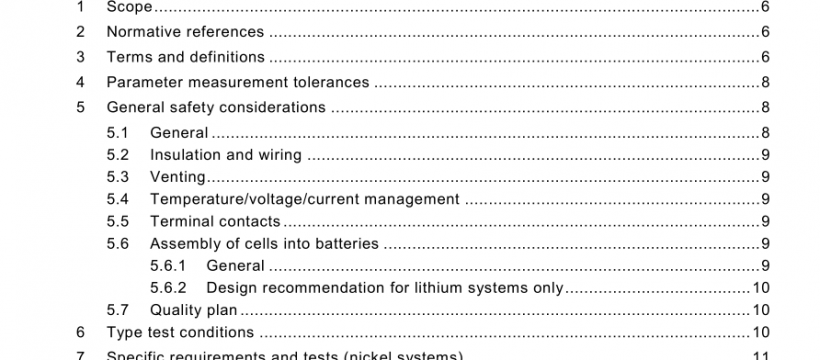IEC 62133:2012 pdf free download
IEC 62133:2012 pdf free download.Secondary cells and batteries containing alkaline or other non-acid electrolytes
5.2 Insulation and wiring
The insulation resistance between the positive terminal and externally exposed metal surfaces of the battery excluding electrical contact surfaces shall be not less than 5 MΩ at 500 V d. c. when measured 60 s after applying the voltage.
Internal wiring and its insulation shall be sufficient to withstand the maximum anticipated current, voltage and temperature requirements. The orientation of wiring shall be such that adequate clearances and creepage distances are maintained between connectors. The mechanical integrity of internal connections shall be sufficient to accommodate conditions of reasonably foreseeable misuse.
5.3 Venting
Battery cases and cells shall incorporate a pressure relief mechanism or shall be so constructed that they will relieve excessive internal pressure at a value and rate that will preclude rupture, explosion and self-ignition. If encapsulation is used to support cells within an outer case, the type of encapsulant and the method of encapsulation shall neither cause the battery to overheat during normal operation nor inhibit pressure relief.
5.4 Temperature/voltage/current management
The design of batteries shall be such that abnormal temperature-rise conditions are prevented. Batteries shall be designed to be within temperature, voltage and current limits specified by the cell manufacturer. Batteries shall be provided with specifications and charging instructions for equipment manufacturers so that associated chargers are designed to maintain charging within the temperature, voltage and current limits specified.
NOTE Where necessary, means can be provided to limit current to safe levels during charge and discharge.
5.5 Terminal contacts
Terminals shall have clear polarity marking on the external surface of the battery. The size and shape of the terminal contacts shall ensure that they can carry the maximum anticipated current. External terminal contact surfaces shall be formed from conductive materials with good mechanical strength and corrosion resistance. Terminal contacts shall be arranged so as to minimize the risk of short circuits.
NOTE Exception: Battery packs with keyed external connectors designed for connection to specific end products need not be marked with polarity markings if the design of the external connector prevents reverse polarity connections.
IEC 62133:2012 pdf free download
